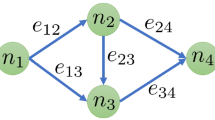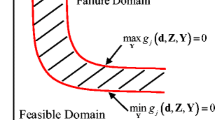Abstract
The precise two-terminal reliability calculation becomes more difficult when the numeral of components of the complex system increases. The accuracy of approximation methods is often adequate for expansive coverage of practical applications, while the algorithms and computation time are typically simplified. As a result, the reliability bounds of two-terminal systems and estimation methods have been established. Our method for determining a complex system's reliability lower and upper bounds employs a set of minimal paths and cuts. This paper aims to present a modern assessment of reliability bounds for coherent binary systems and a comparison of various reliability bounds in terms of subjective, mathematical, and efficiency factors. We performed the suggested methods in Mathematica and approximated their interpretation with existing ones. The observed results illustrate that the proposed Linear and Quadratic bounds (LQb) constraint is superior to Esary-Proschan (EPb), Spross (Sb), and Edge-Packing (EDb) bounds in the lower bond, and the EDb bound is preferable to other methods above in the upper bond. This modification is attributed to sidestepping certain duplicative estimations that are part of the current methods. Given component test data, the new measure supplies close point bounds for the system reliability estimation. The Safety–Critical-System (SCS) uses an illustrative model to show the reliability designer when to implement certain constraints. The numerical results demonstrate that the proposed methods are computationally feasible, reasonably precise, and considerably speedier than the previous algorithm version. Extensive testing on real-world networks revealed that it is impossible to enumerate all minimal paths or cuts, allowing one to derive precise bounds.







Similar content being viewed by others
Abbreviations
- Sb:
-
Spross bound
- EPb:
-
Esary-proschan bound
- EDb:
-
Edge-packing bound
- LQb:
-
Linear and quadratic bound
- SCS:
-
Safety–critical system
- i. i. d.:
-
Independent and identically distributed
- \({x}_{i}\) :
-
A system component
- \(\overline{{x }_{i}}\) :
-
The complement of component \({x}_{i}\) such that \(\overline{{x }_{i}}=1-{x}_{i}\)
- \(Pr({x}_{i})\) :
-
The Probability of component \({x}_{i}\) such that \(Pr\left({x}_{i}\right)={r}_{i}\)
- \({r}_{i}\) :
-
The reliability of component \({x}_{i}\)
- \({q}_{i}\) :
-
The unreliability of component \({x}_{i}\)
- \({\varvec{X}}\) :
-
The vector of all component \({x}_{i}\) of the system
- \({\varvec{P}}\) :
-
The vector of all minimal path \({P}_{i}\) of the system
- \({\varvec{D}}{\varvec{P}}\) :
-
The vector of all disjoint minimal path \(D{P}_{i}\) of the system
- \({\varvec{C}}\) :
-
The vector of all minimal cut \({C}_{i}\) of the system
- \({\varvec{D}}{\varvec{C}}\) :
-
The vector of all disjoint minimal cut \(D{C}_{i}\) of the system
- \(IM\) :
-
Incidence matrix of the system
- \(CM\) :
-
Minimal cut matrix of the system
- \({R}_{Exact}\) :
-
The exact reliability of the system
- \({Q}_{Exact}\) :
-
The exact unreliability of the system
- \({R}_{LB}\) :
-
The reliability lower bound of the system
- \({R}_{UB}\) :
-
The reliability upper bound of the system
- \({B}_{j,r}\) :
-
The Boolean product of \({x}_{i}\) and \(\overline{{x }_{i}}\) for some \({P}_{i}\) or \({C}_{i}\)
- \({A}_{j,i}\) :
-
Sets {\({B}_{j,r}\)} of disjoint products derived from \({P}_{i}\) or \({C}_{i}\)
- \({\alpha }_{i}\) :
-
Portion that are obtained successively from
- \({A}_{j,i}\) :
-
For minimal path \({P}_{i}\)
- \({\beta }_{j}\) :
-
Portion that are obtained successively from
- \({A}_{j,i}\) :
-
For minimal cut \({C}_{j}\)
- \(\mu \left(g\right)\) :
-
A specified lower bound for a spross bound method
- \(\gamma \left(h\right)\) :
-
A specified upper bound for a spross bound method
References
Aggarwal K (1993) Reliability engineering (Vol 3). Springer Science and Business Media
Babaei M, Rashidi-baqhi A (2022) Universal generating function-based narrow reliability bounds to evaluate reliability of project completion time. Reliab Eng Syst Saf 218:108121
Beichelt F, Sproß L (1989) Bounds on the reliability of binary coherent systems. IEEE Trans Reliab 38(4):425–427
Beichelt F (2012) Reliability and maintenance: networks and systems. Chapman and Hall/CRC
Colbourn CJ (1988) Edge-packings of graphs and network reliability. In: Annals of Discrete Mathematics 38 pp 49–61, Elsevier
Datta E, Goyal N (2023) An efficient sum of disjoint product method for reliability evaluation of stochastic flow networks using d-MPs. Int J Syst Assur Eng Manage pp 1–19
Datta E, Goyal NK (2017) Sum of disjoint product approach for reliability evaluation of stochastic flow networks. Int J Syst Assur Eng Manage 8:1734–1749
Esary JD, Proschan F (1963) Coherent structures of non-identical components. Technometrics 5(2):191–209
Gertsbakh I, Shpungin Y (2011) Network reliability and resilience. Springer Science and Business Media
Hassan ZAH, Mutar EK (2017b) Geometry of reliability models of electrical system used inside spacecraft. 2017b Second Al-Sadiq International Conference on Multidisciplinary in IT and Communication Science and Applications (AIC-MITCSA)
Hassan ZA, Mutar EK (2017a) Evaluation the reliability of a high-pressure oxygen supply system for a spacecraft by using GPD method. Al-Mustansiriyah J Coll Educ 2(2):993–1004
Hassan ZAH, Udriște C (2015) Equivalent reliability polynomials modeling EAS and their geometries. Ann West Univ Timisoara-Math Comput Sci 53(1):177–195
Horváth Á (2013) The cxnet complex network analyser software. Acta Polytech Hungarica 10(6):43–58
Jin T, Coit DW (2003) Approximating network reliability estimates using linear and quadratic unreliability of minimal cuts. Reliab Eng Syst Saf 82(1):41–48
Jula N, Costin C (2012) Methods for analyzing the reliability of electrical systems used inside aircrafts. In: Recent Advances in Aircraft Technology. IntechOpen
Kaushik B, Banka H (2015) Performance evaluation of approximated artificial neural network (AANN) algorithm for reliability improvement. Appl Soft Comput 26:303–314
Kuo W, Zuo MJ (2003) Optimal reliability modeling: principles and applications. John Wiley and Sons
Malik S, Chauhan S, Ahlawat N (2020) Reliability analysis of a non series–parallel system of seven components with Weibull failure laws. Int J Syst Assur Eng Manage 11(3):577–582
Marichal J-L (2016) Structure functions and minimal path sets. IEEE Trans Reliab 65(2):763–768
Mi J, Li Y-F, Peng W, Huang H-Z (2018) Reliability analysis of complex multi-state system with common cause failure based on evidential networks. Reliab Eng Syst Saf 174:71–81
Mutar EK (2020) Matrix-based minimal cut method and applications to system reliability. Adv Sci Technol Eng Syst J 5(5):991–996
Mutar EK, Hassan Z (2017) On the geometry of the reliability polynomials. University of Babylon
Mutar EK, Hassan ZAH (2022) New properties of the equivalent reliability polynomial through the geometric representation. In: 2022 International Conference on Electrical, Computer and Energy Technologies (ICECET)
Mutar EK (2022a) Analytical method of calculating reliability sensitivity for space capsule life support systems. Math Probl Eng 2022a
Mutar EK (2022b) Path tracing method to evaluate the signature reliability function of a complex system. J Aerosp Technol Manage 14
Mutar EK (2022c) Reliability analysis of complex safety-critical system with exponential decay failure laws the 6th international conference on SRS
Mutar EK (2022d) Signature of electrical system reliability used inside aircraft IEEE 27th pacific rim international symposium on dependable computing (PRDC)
Pyzdek T, Keller PA (2003) Quality engineering handbook. CRC Press
Rai S, Veeraraghavan M, Trivedi KS (1995) A survey of efficient reliability computation using disjoint products approach. Networks 25(3):147–163
Rausand M (2014) Reliability of safety-critical systems: theory and applications. John Wiley and Sons
Rodionov A, Rodionova O (2013) Exact bounds for average pairwise network reliability. In: Proceedings of the 7th International Conference on Ubiquitous Information Management and Communication
Romero P (2021) Universal reliability bounds for sparse networks. IEEE Trans Reliab 71(1):359–369
Sebastio S, Trivedi KS, Wang D, Yin X (2014) Fast computation of bounds for two-terminal network reliability. Eur J Oper Res 238(3):810–823
Sharma M (2014) Reliability analysis of a non-series parallel network in fuzzy and possibility context. Int J Educ Sci Res Rev 1(2):40–46
Soh S, Rai S (1993) Experimental results on preprocessing of path/cut terms in sim of disjoint products technique. IEEE Trans Reliab 42(1):24–33
Todinov MT (2013) Flow networks: analysis and optimization of repairable flow networks, networks with disturbed flows, static flow networks and reliability networks. Newnes
Wang Z, Zhang J, Huang T (2021) Determining delay bounds for a chain of virtual network functions using network calculus. IEEE Commun Lett 25(8):2550–2553
Xiao Z, Xu X, Xing H, Luo S, Dai P, Zhan D (2021) RTFN: a robust temporal feature network for time series classification. Inf Sci 571:65–86
Xiao Z, Zhang H, Tong H, Xu X (2022) An efficient temporal network with dual self-distillation for electroencephalography signal classification. In: 2022 IEEE International Conference on Bioinformatics and Biomedicine (BIBM)
Xing H, Xiao Z, Zhan D, Luo S, Dai P, Li K (2022) SelfMatch: robust semisupervised time-series classification with self-distillation. Int J Intell Syst 37(11):8583–8610
Yang DY, Frangopol DM (2020) Life-cycle management of deteriorating bridge networks with network-level risk bounds and system reliability analysis. Struct Saf 83:101911
Zhu H, Zhang C (2019) Expanding a complex networked system for enhancing its reliability evaluated by a new efficient approach. Reliab Eng Syst Saf 188:205–220
Funding
No funding is required for the completion of this study.
Author information
Authors and Affiliations
Corresponding author
Ethics declarations
Conflict of interest
There are no conflicts of interest present that would affect the publication of this manuscript.
Additional information
Publisher's Note
Springer Nature remains neutral with regard to jurisdictional claims in published maps and institutional affiliations.
Rights and permissions
Springer Nature or its licensor (e.g. a society or other partner) holds exclusive rights to this article under a publishing agreement with the author(s) or other rightsholder(s); author self-archiving of the accepted manuscript version of this article is solely governed by the terms of such publishing agreement and applicable law.
About this article
Cite this article
Mutar, E.K. Estimating the reliability of complex systems using various bounds methods. Int J Syst Assur Eng Manag 14, 2546–2558 (2023). https://doi.org/10.1007/s13198-023-02108-7
Received:
Revised:
Accepted:
Published:
Issue Date:
DOI: https://doi.org/10.1007/s13198-023-02108-7






